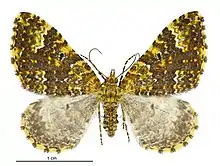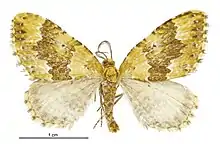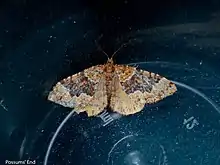| Asaphodes prasinias | |
|---|---|
 | |
| Female | |
 | |
| Male | |
| Scientific classification | |
| Domain: | Eukaryota |
| Kingdom: | Animalia |
| Phylum: | Arthropoda |
| Class: | Insecta |
| Order: | Lepidoptera |
| Family: | Geometridae |
| Genus: | Asaphodes |
| Species: | A. prasinias |
| Binomial name | |
| Asaphodes prasinias | |
| Synonyms[2] | |
| |
Asaphodes prasinias is a moth in the family Geometridae.[2] It is endemic to New Zealand and has been found on both the North and South Islands. This species inhabits native forest including beech forest and subalpine scrub. The range of this species has reduced as this species is regarded as being locally extinct in the previously inhabited open non-forest habitats around Invercargill. Adults are on the wing from November to January.
Taxonomy

This species was first described in 1883 by Edward Meyrick using specimens collected by Castle Hill in Canterbury by J. D. Enys and named Larentia prasinias.[3][4] Meyrick gave a fuller description of the species later in 1884.[4] George Hudson discussed the species in his 1898 volume New Zealand moths and butterflies and referred to it as Xanthorhoe prasinias.[5] Hudson discussed and illustrated also this species under that name in his 1928 publication The butterflies and moths of New Zealand.[6] In 1939 Louis Beethoven Prout confirmed the placement of this species in the genus Larentia.[7] This placement was not accepted by New Zealand taxonomists.[8] In 1971 J. S. Dugdale placed this species in the genus Asaphodes.[9] This placement was reaffirmed by Dugdale in 1988.[2] The male lectotype, collected at Castle Hill, is held by the Natural History Museum, London.[2]
Description
.jpg.webp)
Meyrick described this species as follows:
Male, female. 26-29 mm. Forewings moderate, hindmargin slightly sinuate; bright yellow; numerous cloudy confused dentate brownish striae; a moderately broad rather dark fuscous median band, including a large ill defined clear yellow patch on upper half, containing a black dot; its margins dentate, anterior margin concave, posterior margin moderately angulated in middle, sinuate above; a subterminal row of small dark fuscous spots; cilia yellow, barred with dark fuscous. Hindwings moderate, hindmargin rounded ; pale yellow; basal half finely and obscurely striated with bluish grey; hindmargin reddish-tinged, with a subterminal row of small grey spots.[4]
The appearance of this species can vary in the depth of ground colour, as well as the width of the transverse lines, on the forewings.
Distribution
This species is endemic to New Zealand in both the North and South Islands.[1][6] Along with the type locality of Castle Hill this species has also been observed at Mount Taranaki, in the North Island, and at Mount Arthur, Arthur's Pass, Otira, Lake Wakatipu, and Invercargill.[5][6] Although found in subalpine habitat, in the extreme south of the country, it can be observed in low land situations.[6] The range of this species has reduced as this species is regarded as being locally extinct in the previously inhabited open non-forest habitats around Invercargill.[10]
Habitat
This species inhabits native forest including beech forests and subalpine scrub.[5][6] Hudson stated that A. prasinias is attracted to Coprosma paviflora.[6]
Behaviour
The adults of this species is on the wing from November to January.[5][6]
Hosts
The larvae of this species have been raised on species in the genus Ranunculus.[11]
References
- 1 2 "Asaphodes prasinias (Meyrick, 1883)". www.nzor.org.nz. Retrieved 2022-01-22.
- 1 2 3 4 John Stewart Dugdale (23 September 1988). "Lepidoptera - annotated catalogue, and keys to family-group taxa". Fauna of New Zealand. Department of Scientific and Industrial Research. 14: 174. doi:10.7931/J2/FNZ.14. ISSN 0111-5383. Wikidata Q45083134.
- ↑ Edward Meyrick (September 1883). "Monograph of New Zealand Geometrina". New Zealand Journal of Science. 1: 528. Wikidata Q110691894.
- 1 2 3 Edward Meyrick (May 1884). "A Monograph of the New Zealand Geometrina". Transactions and Proceedings of the New Zealand Institute. 16: 81–82. ISSN 1176-6158. Wikidata Q109615359.
- 1 2 3 4 George Vernon Hudson (1898), New Zealand moths and butterflies (Macro-lepidoptera), Illustrator: George Hudson, London, p. 65, doi:10.5962/BHL.TITLE.7912, OCLC 980865393, Wikidata Q19073637
{{citation}}: CS1 maint: location missing publisher (link) - 1 2 3 4 5 6 7 George Vernon Hudson (1928), The butterflies and moths of New Zealand, Illustrator: George Hudson, Wellington: Ferguson and Osborn Limited, p. 116, LCCN 88133764, OCLC 25449322, Wikidata Q58593286
- ↑ Prout, L. B. (1939). "Geometridae: Fauna Indo-Australica". The Macrolepidoptera of the World. 12: 264 – via Biodiversity Heritage Library.
- ↑ R. C. Craw (April 1987). "Revision of the genus Helastia sensu stricto with description of a new genus (Lepidoptera: Geometridae: Larentiinae)". New Zealand Journal of Zoology. 14 (2): 269–293. doi:10.1080/03014223.1987.10422997. ISSN 0301-4223. Wikidata Q54670161.
- ↑ J. S. Dugdale (10 November 1971). "Entomology of the Aucklands and other islands south of New Zealand: Lepidoptera, excluding non-crambine Pyralidae" (PDF). Pacific Insects Monographs. 27: 55–172. ISSN 0078-7515. Wikidata Q64006453.
- ↑ Brian Patrick (1 July 2014). "Ecology and conservation of the rare moth Asaphodes frivola Meyrick". The Wētā. 47: 17–38. ISSN 0111-7696. Wikidata Q105344866.
- ↑ Brian H. Patrick (April 2000). Conservation status of two rare New Zealand geometrid moths (PDF). Vol. 145. pp. 1–21. ISBN 0-478-21946-6. ISSN 1173-2946. Wikidata Q109608608.
{{cite book}}:|journal=ignored (help)